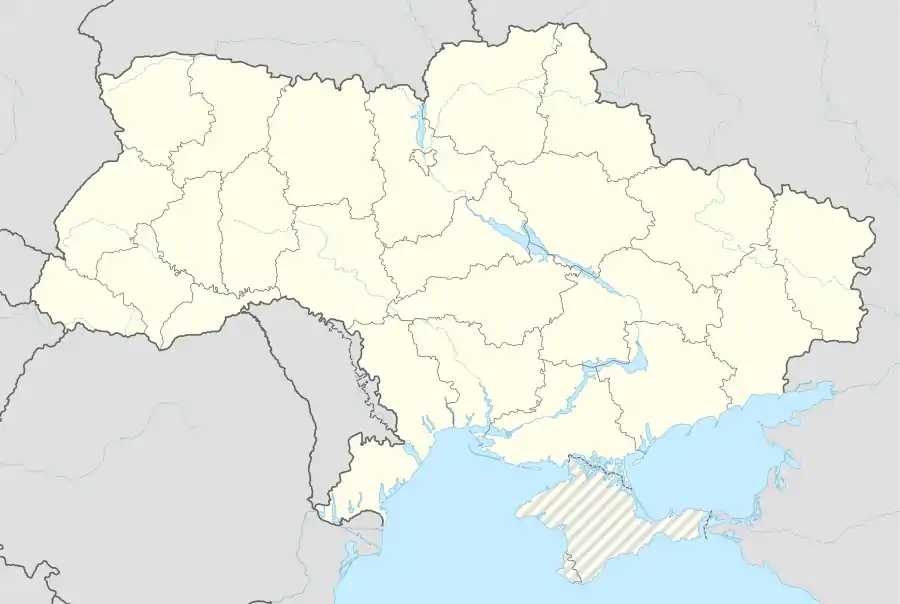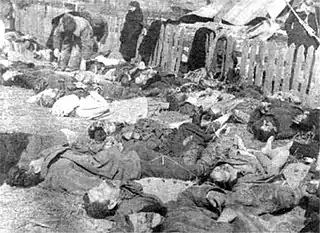Huta Pieniacka
Huta Pieniacka (Ukrainian: Гута Пеняцька, Huta Penyats'ka) – was an ethnic Polish village of about 1,000 inhabitants until 1939,[1] located in Tarnopol Voivodeship, Poland (modern-day Brody Raion, Lviv Oblast, Ukraine). The site of what was once the village is currently located some 50 km from Ternopil, beside the village of Holubytsia (Ukrainian: Голубиця) and Peniaky in Brody Raion of Lviv Oblast of Ukraine.
Huta Pieniacka | |
|---|---|
Village (destroyed) | |
 Huta Pieniacka monument | |
 Huta Pieniacka Location of eradicated village | |
| Coordinates: 49.902°N 25.099°E | |
| Country | |
| Destroyed | 1944, occupied Poland (now Ukraine) |
History
During the German-Soviet War the village was the location of the Soviet partisan detachment under the command of NKVD colonel Dmitry Medvedev.
On February 28, 1944 almost all the villagers of Polish ethnic background were murdered,[2] and the village razed during the Huta Pieniacka massacre in a pre-planned pacification action,[3] by the 4th police regiment, which was later adjoined to the SS Galizien (the conclusion of both Polish and Ukrainian historical commissions).[4][5] The village of Huta Pieniacka no longer exists. Most of the houses were burned during the massacre and only the school and a Roman Catholic church remained. Both of these buildings were demolished after the war, and in the area of the village there is a pasture for cattle. There is a post with a Ukrainian inscription Center of the former village, but it does not mention the name of the village.
Recent events

In 2009, the then presidents of the two countries, Lech Kaczyński and Viktor Yushchenko respectively, visited the site to pay tribute to the victims.
The monument in the now non-existent village of Huta Pieniacka in Lviv region in western Ukraine was erected in memory of the hundreds of people who lived in the then Polish village and were brutally killed in 1944 by a police regiment.
On the 9th of January 2017 the Monument to Polish Victims of World War II Massacre was vandalized. A cross made of stone was blown up, while two stone tables with the names of the Poles killed during the 1944 massacre were damaged allegedly by vandals from Russian "People's Liberation Movement" who were one the first who published video of destroyed monument. This act was strongly condemned by both Ukrainian and Polish authorities.[6]
Memorial was restored in a month. Ambassador of Poland in Ukraine Jan Pieklo visited memorial on 28th of February 2017 during remembrance ceremony and called it "a huge surprise". "This was a miracle of sorts. First, there was information that a cross returned to its place. A consulate employee went to Huta Pieniacka and returned with photos confirming the news. It is a replica of the original cross and it is made of granite", said Jan Pieklo.[7]
References
- Geographical Dictionary of Poland. Vol III. Internet Archive.
- Marcin Wojciechowski (2009-02-27), 65 years ago the Polish village in Ukraine was pacified. What happened in Huta Pieniacka (65 lat temu spacyfikowano polską wieś na Ukrainie. Co stało się w Hucie Pieniackiej), Gazeta Wyborcza, Internet Archive. (in Polish)
- "IPN prowadzi śledztwo ws. mordu w Hucie Pieniackiej - GazetaPrawna.pl - biznes, podatki, prawo, finanse, wiadomości, praca -". gazetaprawna.pl. Retrieved 2016-05-15.
- Rudling, Per Anders (2013). "The Return of the Ukrainian Far Right: The Case of VO Svoboda". Routledge Critical Studies in Discourse. Routledge. p. 239. ISBN 978-0-415-89919-2.
- Michael James Melnyk. (2007). To Battle: The Formation and History of the 14th Waffen-SS Grenadier Division. Helion and Company. Chapter 5.
- "Ukraine / MFA: events in Huta Pieniacka are an act of barbarism - PAP dispatch from 13 January 2017". www.msz.gov.pl. Retrieved 2019-02-27.
- "A surprise restoration of Polish memorial by Ukrainians | Polska Agencja Prasowa SA". www.pap.pl. Retrieved 2019-02-27.
